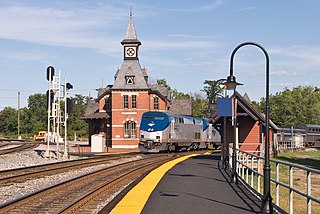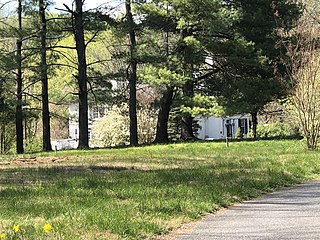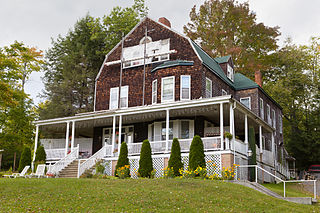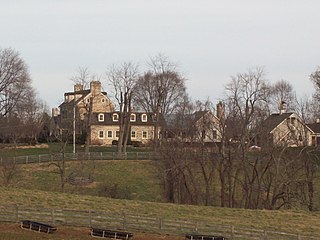
The Thomas Viaduct spans the Patapsco River and Patapsco Valley between Relay, Maryland and Elkridge, Maryland, USA. It was commissioned by the Baltimore and Ohio Railroad (B&O); built between July 4, 1833, and July 4, 1835; and named for Philip E. Thomas, the company's first president. It remains the world's oldest multiple arched stone railroad bridge.

The Patterson Viaduct was built by the Baltimore and Ohio Railroad (B&O) as part of its Old Main Line during May to December 1829. The viaduct spanned the Patapsco River at Ilchester, Maryland. It was heavily damaged by a flood in 1866 and subsequently replaced with other structures.

Point of Rocks is a historic passenger rail station on the MARC Brunswick Line between Washington, D.C., and Martinsburg, WV, located at Point of Rocks, Frederick County, Maryland, United States. The station was built by the Baltimore and Ohio Railroad in 1873, and designed by E. Francis Baldwin. It is situated at the junction of the B&O Old Main Line and the Metropolitan Branch. The Met Branch also opened in 1873 and became the principal route for passenger trains between Baltimore, Washington and points west.

The Commodore Joshua Barney House is a historic home located at Savage, Howard County, Maryland, United States. It was originally situated on a 700-acre tract in modern Savage Maryland named Harry's Lot, at a time when the closest town was Elk Ridge. In 1809, Nathaniel F. Williams (1782-1864) married Caroline Barney, daughter of Joshua Barney, who in turn expanded an existing mill site on the property to create the Savage Mill.

Roberts Inn, is a historic home and farm located at Cooksville, Howard County, Maryland. The complex consists of a 2+1⁄2-story stuccoed stone house with a reconstructed log wing built about 1808, and several 19th- to early-20th-century agricultural outbuildings, including a frame bank barn, a frame ground barn, a tile dairy, and a frame silo. The construction of the house coincided with the extension of the National Pike through the Cooksville area. Documentary and architectural evidence supports its use as a turnpike tavern from an early date. Tradition holds that Marquis de Lafayette breakfasted at Roberts Inn during his 1824 tour of America.

Troy, also known as Troy Hill Farm, is a historic slave plantation home located at Elkridge, Howard County, Maryland, United States. It is associated with the prominent Dorsey family of Howard County, who also built Dorsey Hall.

The Elkridge Furnace Complex is a historic iron works located on approximately 16 acres (6.5 ha) at Elkridge, Howard County, Maryland.

The Inns on the National Road is a national historic district near Cumberland, Allegany County, Maryland. It originally consisted of 11 Maryland inns on the National Road and located in Allegany and Garrett counties. Those that remain stand as the physical remains of the almost-legendary hospitality offered on this well-traveled route to the west.

The Pennington Cottage is a historic home located at Deer Park, Garrett County, Maryland, United States. It is a 2+1⁄2-story, late-19th-century Shingle-Style frame structure, with a gambrel roof and a one-story porch that stretches across the principal facade and along portions of the sides. The house is entirely covered with dark wood shingles. It was built as a part of the Baltimore and Ohio Railroad's Deer Park Hotel complex, as the summer home of Baltimore architect Josias Pennington.

Brooklandville House, or the Valley Inn, is a historic restaurant and tavern building, and a former inn, located in Brooklandville, Baltimore County, Maryland. It is a 2+1⁄2-story stone structure facing the former railroad and dating from about 1832. It is associated with the Baltimore and Susquehanna Railroad, which crossed the property just to the south.

Choate House is a historic home located at Randallstown, Baltimore County, Maryland. It is a 2+1⁄2-story gable-roofed stone building built in 1810, with a porch and dormers added in the 1880s. The Italianate style was probably applied in the 1880s and include a full-length porch.

The Cloisters, also known as Cloisters Castle, is a historic home in Lutherville, Baltimore County, Maryland, United States. It was built about 1930 and is a 2+1⁄2-story house, irregular in elevation and plan with much architectural ornament. It is built of large, random-sized blocks of a native gray and gold colored rock known as Butler stone, with details principally of sandstone, wood from the site, plaster, and wrought iron. The main façade is dominated by two asymmetrically placed, projecting sections topped by massive half-timbered gables which were originally part of a Medieval house in Domrémy, France. It also has a massive stone octagonal stair tower, which contains a stone and wrought-iron spiral staircase and is crowned by a crenellated parapet and a small, round, stone-roofed structure from which one can exit onto the roof of the main tower. The house's roof is constructed of overlapping flagstones secured by iron pins, the only roof of this kind in America.

Hilton is a historic home located at The Community College of Baltimore County in Catonsville, Baltimore County, Maryland. It is an early-20th-century Georgian Revival–style mansion created from a stone farmhouse built about 1825, overlooking the Patapsco River valley. The reconstruction was designed by Baltimore architect Edward L. Palmer, Jr. in 1917. The main house is five bays in length, two and a half stories above a high ground floor, with a gambrel roof. The house has a 2+1⁄2-story wing, five bays in length, with a gabled roof, extending from the east end; and a two-story, one-bay west wing. The roof is covered with Vermont slate. The house features a small enclosed porch of the Tuscan order that was probably originally considered a porte cochere.

The Meadows is a historic home and farm compound located at Owings Mills, Baltimore County, Maryland, United States. The house is an L-shaped 2+1⁄2-story stone house built in the 18th century and occupied for approximately 80 years by various members of the Owings family, for whom Owings Mills was named. Also on the property is a 2+1⁄2-story stone slave house, an 18th-century stone and timber stable, and a 2-story log and clapboard tenant house.

Stone Hall is a historic home located at Cockeysville, Baltimore County, Maryland, United States. It is a manor house set on a 248-acre (1.00 km2) estate that was originally part of a 4,200-acre (17 km2) tract called Nicholson's Manor. It was patented by William Nicholson of Kent County, Maryland in 1719. The property in what is now known as the Worthington Valley was split up in 1754 and sold in 1050-acre lots to Roger Boyce, Corbin Lee, Brian Philpot, and Thinsey Johns.

Rigbie House, also known as "Phillip's Purchase", is a historic home located at Berkley, Harford County, Maryland. It is a 1+1⁄2-story, frame and stone structure built about 1781. It was one of a series of forest outposts fortified against the Indians and representing Lord Baltimore’s claim of 1632 to land extending north to the 40th parallel. In April 1781, it was the place where the Marquis de Lafayette’s officers quelled a mutiny that might have prevented his army of New England troops, who had been headed homeward, from turning south again to join General Greene and General Washington at Yorktown, in which case that battle might never have been fought.

Gladden Farm, also known as Gladden-Roming Stone House, is a historic home and farm complex located in Street, Maryland. The complex includes three historically-significant structures: a large five-bay rubblestone bank house with Federal detailing, a one-story rubblestone spring house, and a one-story board-and-batten frame shop.

Creagerstown is an unincorporated community in Frederick County, Maryland, United States. It is playfully known by its residents as "4 miles from everywhere" because of its situation at 4 miles (6.4 km) from Thurmont, Woodsboro, Rocky Ridge, and Lewistown.

Johnsville is an unincorporated community in Frederick County, Maryland, United States. It is located approximately halfway between Libertytown and Union Bridge along Maryland Route 75. The Kitterman-Buckey Farm was listed on the National Register of Historic Places in 2005.

The Bare Hills Historic District encompasses a residential area north of Baltimore, Maryland, in Baltimore County, which had industrial beginnings before being transformed into a suburb of the city. The district includes Lake Roland Park as well as a cluster of largely vernacular dwellings between the park and Falls Turnpike that was built mainly in the 19th century.
























